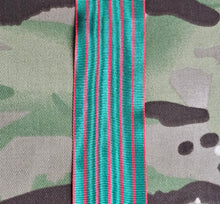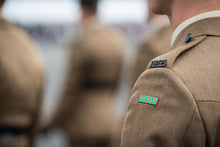- Choose Your size option
- Great Quality Original Water Style Ribbon
- Choose your length
- Picture shows the full size option
- Worn on upper Left Arm in No1 Dress / No2 Dress / Mess Dress
Royal Army Medical Service
Croix De Guerre, original citation by Marshal Pétain when he bestowed the Croix de Guerre to 24th (1st wessex) Field Hospital. The citation is kept at Exeter Cathedral and the tradition of the unit is continued by 243rd (The Wessex) Field Hospital (23 MMR). Recently passed onto the newly formed RAMS (Royal Army Medical Service.
The Rifles
In The Rifles, an honorific medal is worn on the upper arm. This is called the Croix de Guerre, or ‘Cross of War’, and comes from the French military medal of the same name. But how and why did a British Army Regiment come to be wearing a French medal?
The Croix de Guerre was first introduced in 1915, during the First World War. The ribbon features vertical green and red stripes, while the medal itself consists of a bronze cross, with crossed swords behind. In the centre of the medal, on the obverse side, a bust of Marianne (the personification of the French Republic) can be seen. On the reverse, a circle surrounds the dates of the conflict for which the medal was awarded (for example: 1914-1918). The Croix de Guerre is awarded for courage in battle. Unlike most military medals, it can be awarded to both individuals and units for their heroic actions. An antecedent of The Rifles was one such unit.
On the 27th May 1918, the Germans began the Third Battle of the Aisne. The German 1st and 7th Armies attacked the French 6th Army, which was supported by the IX British Corps and, later, two American divisions. Employing massed heavy artillery, close air support, poisoned gas and elite stormtroopers, the Germans threatened to breakthrough. As Allied forces withdraw, only one battalion remained – the 2nd Battalion, the Devonshire Regiment.
The 2/DEVONS were understrength and exhausted. Having recently seen fierce fighting, they had been relocated to was thought to be a relatively quiet stretch of the front – the wooded hill of Bois de Buttes. The officer commanding the Battalion, Lt Col Anderson-Morshead, summarised the situation to his men: “Your job for England, men, is to hold the blighters up as much as you can, to give our troops a chance on the other side of the River. There is no hope of relief we have to fight to the last”.
For eight hours, the Devons defeated repeated assaults, despite being hopelessly outnumbered and soon surrounded. The presence of enemy forces in area that the Germans assumed was safe, greatly slowed the speed of reinforcements and supplies which were vital to the offensive. Even after suffering heavy causalities, the Battalion continued to launch aggressive counterattacks, successfully destroying an artillery battery, which was advancing past Bois de Buttes.
Eventually, through heavy casualties and lack of ammunition, 2/DEVONS were overrun and wiped out. Virtually the entire battalion, 29 officers and 552 men, were either killed or captured. Lt Col Anderson-Morshead was among the dead. Only a handful were able to retreat to the Aisne River, swim across it and make their way through German lines to reach friendly forces. When the Battalion was assembled a few weeks later, they numbered only 40 men.
The supreme bravery and sacrifice of the men of 2/DEVONS was recognised by the French government, which awarded them the Croix de Guerre. The Devonshire Regiment received the battle honour Bois des Buttes. With the formation of the Devonshire and Dorset Regiment in 1958, the Croix de Guerre was carried over as the arm badge of the Regiment. In 2007, the D and D LI were one of the forming regiments of The Rifles. The Croix de Guerre continues to be worn as an arm badge and is one of the current Regiment’s ‘Golden Threads’, which links it to the four forming regiments.
An interesting note is that the Devons were not the only antecedent of The Rifles to be awarded the Croix de Guerre during the First World War. The medal was also presented to the 4th Battalion, the Kings Shropshire Light Infantry, for its heroic capture of Blingny Hill during the Second Battle of the Marne. The awarding of the Croix de Guerre to a territorial battalion was very rare. The French medal would go on to appear on the Regimental Colour of KSLI and was worn on the arm. After the KSLI was amalgamated to form The Light Infantry in 1967, 5LI continued to wear it.
Credit: The Rifles Museum




